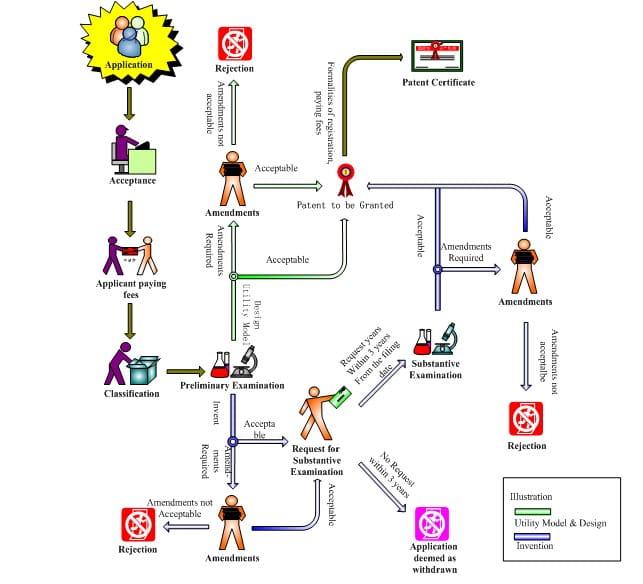Filing a patent application in China involves a structured process that grants inventors exclusive rights to their innovations. Understanding the procedural steps and legal requirements is crucial for securing patent protection effectively.
Legal Framework
The legal framework governing patents in China is primarily established by domestic laws and international treaties.
- Domestic Laws:
- Patent Law of the People’s Republic of China: This law outlines the fundamental principles and procedures for patent protection in China.
- Implementing Regulations of the Patent Law: These regulations provide detailed guidelines for the application and enforcement of the Patent Law.
- International Treaties:
- Paris Convention: An international agreement that facilitates the protection of industrial property across member countries.
- Patent Cooperation Treaty (PCT): A treaty that streamlines the process of filing patent applications in multiple countries through a single international application.
- Hague Agreement: This agreement allows for the international registration of industrial designs.
Governing Authority
The China National Intellectual Property Administration (CNIPA) is the primary authority responsible for patent applications, reexaminations, invalidations, and administrative enforcement.
Read more about the official guidelines for all kinds of IP administrative matters.
Patent Enforcement in China
In China, the enforcement of patent rights involves both administrative and judicial approaches:
- Administrative Enforcement: The China National Intellectual Property Administration (CNIPA) and local intellectual property offices handle patent infringement disputes, offering quick and cost-effective solutions, including injunctions and destruction of infringing products.
- Judicial Enforcement: Specialized intellectual property courts across China hear IP infringement cases. Remedies include injunctions, damages, and the destruction of infringing products.
For insights into enforcement trends, refer to the latest WIPO report on patent cases in China.
Types of Patents in China
China recognizes three primary categories of patents:
- Invention: mean a new technical scheme proposed for a product, a process or the improvement thereof.
- Utility Model: mean an applicable and practical new technical scheme proposed for the shape or structure of a product or a combination thereof.
- Design: mean a new design of the whole or partial shape or pattern of a product, or a combination thereof, as well as a combination of color with shape or pattern, which creates an aesthetic feeling and is fit for industrial application. See more about the requirements of design registration in China.
Differences Among the Three Types
| Aspect | Invention | Utility Model | Design |
|---|---|---|---|
| Protection Term | 20 years | 10 years | 15 years |
| Examination Process | Substantive examination; higher patentability requirements; longer duration (1-3 years) | Formal examination; lower patentability requiredments; shorter duration (6-12months) | Formal examination; shorter duration (6-9months) |
| Subject Matter | Technical solutions (products, methods), including processes, chemical compounds, pharmaceuticals, or software | Technical solutions (product’s shape, structure) | Product appearance (shape, colors, pattern) |
Eligibility Criteria for Patentability
In addition to novelty, inventiveness, and industrial applicability, the subject matter of a patent application must not fall into any of the following categories:
- Scientific discoveries;
- Rules and methods for intellectual activities;
- Methods of diagnosis/ treatment for diseases;
- Animal and plant varieties (however, their production methods can be patented);
- Methods of nuclear transformation and substances obtained through such methods;
- Designs primarily serve as identification through patterns, colors, or their combination on printed materials.
Application Routes
- Direct Application: Applicants can file directly in China.
- Paris Convention Route: Applicants can claim priority within 12 months (for invention or utility model) or 6 months (for design) from the first filing in another member country.
- PCT Route: Applicants can file an international application under the Patent Cooperation Treaty, designating China among other member countries. See more about the national phase in China.
Required Documents for Patent Filing
- Invention Patent: Request form, claims, description, and necessary drawings.
- Utility Model Patent: Request form, claims, description, and drawings.
- Design Patent: Request form, images or photographs, and a brief description. See more about the requirements for the design drawings.
- Power of Attorney: If filing through an agent.
- Priority Documents: certified copy or DAS code of earlier applications where priority is claimed.
Cost of Filing a Patent in China
The costs involved include:
- Official Fees: Filing, examination, and grant fees. See more about the patent fee schedule in China.
- Professional Fees: If engaging a patent agent.
- Translation Fees: If claiming prior application in a foreign language.
- Annual Maintenance Fees: To keep the patent in force.
Application Procedure
- Filing: Apply with CNIPA, including all required documents. A patent search is strongly recommended before filing.
- Preliminary Examination: CNIPA conducts a formal examination to ensure the application meets procedural requirements.
- Publication: For invention applications, the application is published after 18 months from the first filing date.
- Substantive Examination: For invention applications, a substantive examination is conducted upon request within 3 years from the first filing date to assess patentability.
- Grant: Once all requirements are met, the patent is granted, and details are published in the patent gazette.

Application Timeline
- Invention Patents: Typically take 2 to 4 years from filing to grant, due to the substantive examination process.
- Utility Model and Design Patents: Generally granted within 6 to 12 months, as they undergo only formal examination.
Engaging a Registered Patent Agent
Foreign applicants without a residence or business office in China must engage a registered Chinese patent agent to act on their behalf.
Reexamination of Rejected Applications
Applicants can request reexamination within three months of receiving a rejection decision from CNIPA.
If dissatisfied with the reexamination decision, they may appeal to the Beijing Intellectual Property Court within three months.

Post-Grant Maintenance and Enforcement
Maintaining Patent Rights
After the grant, maintaining the patent requires the payment of annual fees for the next year to keep the patent in force. Failure to pay these fees can result in the lapse of patent rights.
See more about the annual fee schedule in China.
Patent Invalidation
After a patent is granted, any party may request CNIPA to invalidate the patent if it believes the patent does not meet legal requirements.
If dissatisfied with the invalidation decision, either party can appeal to the Beijing Intellectual Property Court within three months.

Further Information
Read more about patent fee schedule in China.
Read more about trademark registration in China.
Secure Your Patent in China Today
Filing a patent in China is a critical step for protecting your innovation in a competitive market. To navigate the complexities of the process, work with a trusted patent agent or law firm.
For expert assistance in Chinese patent applications, contact our team today!

